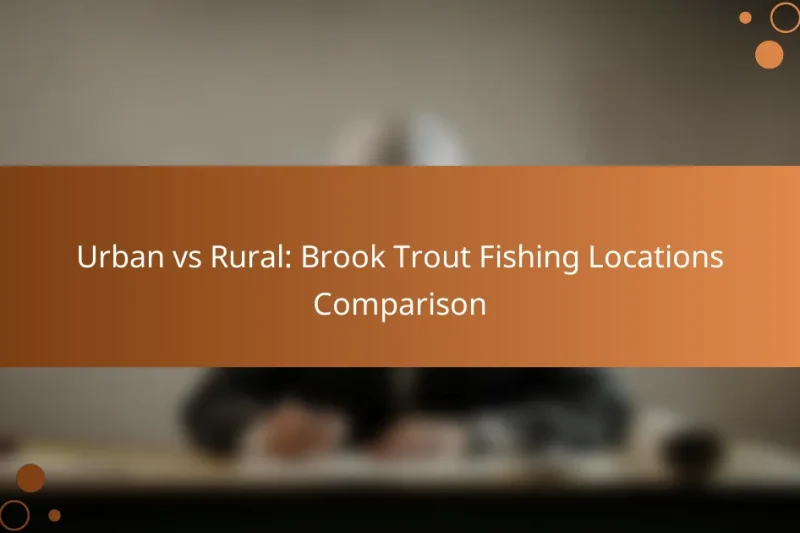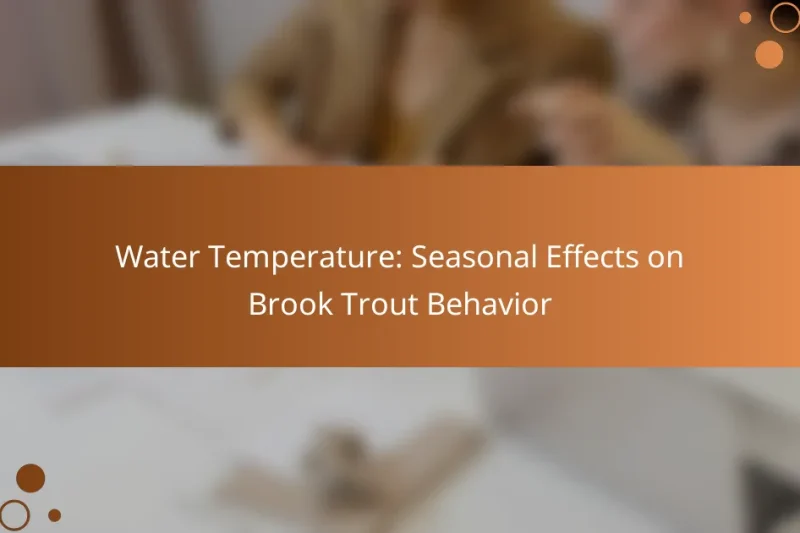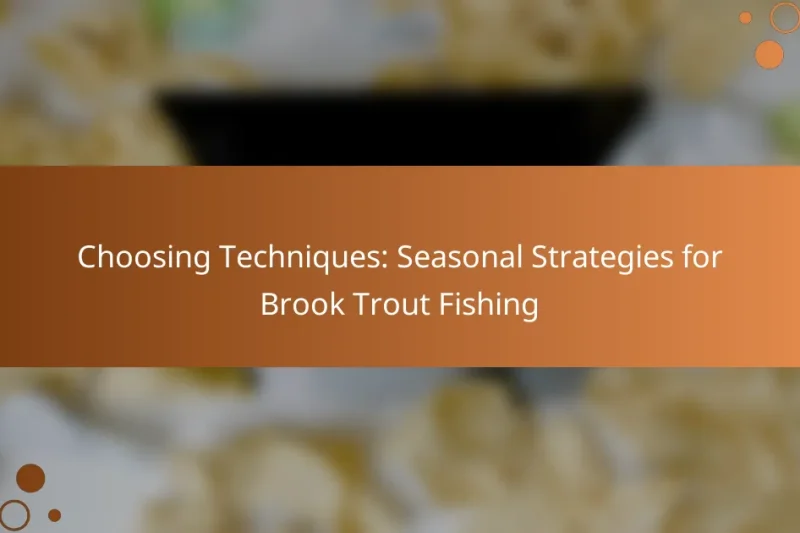Weather changes play a crucial role in influencing the feeding behavior of Brook Trout, impacting their … Weather Changes: Influence on Brook Trout Feeding BehaviorRead more
Brook trout fishing offers an exciting challenge for anglers seeking to catch these beautiful freshwater fish found in cold, clear waters across North America. With the right equipment and techniques, including fly fishing and spin fishing, you can enhance your chances of a successful outing. This guide will provide you with essential tips and insights to make the most of your brook trout fishing experience.
Urban vs Rural: Brook Trout Fishing Locations Comparison
When comparing brook trout fishing locations, urban areas offer convenient access to well-stocked water bodies, allowing … Urban vs Rural: Brook Trout Fishing Locations ComparisonRead more
Seasonal Patterns: Brook Trout Fishing in Northern States
Brook trout fishing in the Northern States is best enjoyed from spring through fall, with peak … Seasonal Patterns: Brook Trout Fishing in Northern StatesRead more
Water Temperature: Seasonal Effects on Brook Trout Behavior
Water temperature plays a crucial role in shaping brook trout behavior throughout the seasons. In spring, … Water Temperature: Seasonal Effects on Brook Trout BehaviorRead more
Brook Trout Conservation: Local Initiatives, Volunteer Opportunities and Community Engagement
Brook Trout conservation is vital for maintaining healthy aquatic ecosystems and enhancing local biodiversity. Community engagement … Brook Trout Conservation: Local Initiatives, Volunteer Opportunities and Community EngagementRead more
Brook Trout Feeding Patterns: Rivers and Lakes Comparison
Brook trout exhibit distinct feeding patterns in rivers and lakes, shaped by the unique characteristics of … Brook Trout Feeding Patterns: Rivers and Lakes ComparisonRead more
Prime Habitats: Identifying Brook Trout Locations
Brook trout thrive in cold, clean freshwater streams and rivers, predominantly found in mountainous regions and … Prime Habitats: Identifying Brook Trout LocationsRead more
Brook Trout Behavior: Natural and Stocked Waters Differences
Brook trout behavior exhibits notable differences between natural and stocked waters, influenced by habitat conditions, food … Brook Trout Behavior: Natural and Stocked Waters DifferencesRead more
Choosing Techniques: Seasonal Strategies for Brook Trout Fishing
Choosing the right techniques for brook trout fishing requires an understanding of seasonal changes and how … Choosing Techniques: Seasonal Strategies for Brook Trout FishingRead more
Behavior Insights: Enhancing Your Brook Trout Fishing Success
Enhancing your brook trout fishing success in the Northeast requires a keen understanding of their behavior … Behavior Insights: Enhancing Your Brook Trout Fishing SuccessRead more
Where to Find Brook Trout in North America?
Brook trout are commonly found in cold, clear streams and lakes across North America, particularly in the eastern and northern regions. They thrive in areas with ample cover, such as rocks and submerged vegetation, and prefer water temperatures ranging from 50°F to 65°F.
Popular rivers and lakes
Some of the most renowned rivers for brook trout fishing include the Ausable River in New York and the Roaring Fork River in Colorado. Lakes like Lake Placid in New York and the many glacial lakes in the Adirondacks are also prime locations. These waters provide excellent habitats with the right conditions for brook trout.
When fishing in rivers, look for pools, riffles, and undercut banks where brook trout often hide. In lakes, focus on the edges and drop-offs where the water temperature is cooler.
Best states for brook trout fishing
States like New York, Pennsylvania, and Vermont are top destinations for brook trout anglers. These states offer a mix of pristine rivers and lakes, along with regulations that support healthy brook trout populations. Maine is also notable for its vast wilderness areas where brook trout thrive.
Consider checking local fishing reports and regulations, as some areas may have specific seasons or limits to protect these fish.
Seasonal hotspots
Spring is often the best time for brook trout fishing, as they are actively feeding after winter. Look for them in shallow waters where they spawn. In summer, focus on cooler parts of the day, such as early morning or late evening, as brook trout seek refuge from warmer temperatures.
Fall can also be productive, as brook trout prepare for winter. Target areas with abundant food sources, such as insects and smaller fish, to increase your chances of a successful catch.
What Equipment is Needed for Brook Trout Fishing?
To successfully fish for brook trout, you'll need specific equipment tailored to their habitat and behavior. Essential items include fishing rods, reels, lures, and bait that are suitable for targeting these freshwater fish.
Essential fishing gear
Your essential fishing gear for brook trout includes a lightweight rod, a spinning reel, and a fishing line with a test strength of around 4-8 pounds. This setup allows for better sensitivity and control when casting in smaller streams and lakes where brook trout are commonly found.
Additionally, a fishing tackle box with various tools such as pliers, scissors, and a net will help you manage your catch efficiently. Don't forget to bring along a fishing license, as regulations may vary by location.
Recommended fishing rods and reels
For brook trout fishing, a 5 to 6-foot spinning rod is ideal, providing the right balance of flexibility and strength. Pair this with a lightweight spinning reel that has a smooth drag system to handle the quick movements of brook trout.
Look for reels that are easy to operate and have a gear ratio that allows for quick retrieval. Brands like Shimano and Pflueger offer reliable options that are popular among anglers.
Best lures and baits
When targeting brook trout, using small lures such as spinners, spoons, or jigs can be very effective. Colors like silver, gold, or bright patterns often attract their attention in clear waters.
Live bait such as worms, minnows, or small insects can also yield good results. Experimenting with different types of lures and baits based on the season and water conditions will help you determine what works best in your fishing location.
What Techniques Work Best for Catching Brook Trout?
Effective techniques for catching brook trout include fly fishing, spin fishing, and ice fishing. Each method has its own advantages and considerations, making it essential to choose the right approach based on conditions and personal preference.
Fly fishing techniques
Fly fishing for brook trout typically involves using lightweight rods and artificial flies that mimic local insects. Focus on casting near structures like rocks and fallen trees where trout tend to hide. Early morning and late evening are often the best times for this technique.
Consider using dry flies during hatches or nymphs when trout are feeding below the surface. A good rule of thumb is to match the size and color of your flies to the insects present in the water.
Spin fishing methods
Spin fishing for brook trout utilizes spinning reels and lures such as spinners, spoons, or small jigs. This method allows for versatile presentations, making it easier to cover large areas of water. Use light tackle to enhance sensitivity and improve your chances of detecting bites.
When spin fishing, aim for deeper pools and slower currents, especially during warmer months. A common tip is to retrieve lures at varying speeds to find what triggers the trout's interest.
Ice fishing strategies
Ice fishing for brook trout requires specialized gear, including an auger to drill holes and tip-ups or jigging rods. Target areas with at least 12-15 inches of ice for safety, and look for underwater structures or drop-offs where trout are likely to congregate.
Use live bait like minnows or artificial jigs that mimic small fish. Setting tip-ups at different depths can help determine where the trout are feeding. Always check local regulations regarding ice fishing limits and gear requirements to ensure compliance.
What are the Regulations for Brook Trout Fishing?
Brook trout fishing regulations vary by region and are designed to protect fish populations and ensure sustainable fishing practices. Familiarizing yourself with these rules is essential for a successful and responsible fishing experience.
Licensing requirements
Before fishing for brook trout, you must obtain the appropriate fishing license for your state or region. Most areas require an annual or daily fishing license, which can typically be purchased online or at local retailers.
Some states may also have specific permits for fishing in designated waters or for certain techniques, such as fly fishing. Always check local regulations to ensure compliance.
Size and bag limits
Size and bag limits for brook trout are established to maintain healthy populations. Commonly, anglers are allowed to keep a limited number of fish, often ranging from 2 to 5 per day, depending on the water body.
Size limits may also apply, with many regions requiring that brook trout be a minimum length, often around 8 to 12 inches, to be kept. Always verify the specific limits for the waters you plan to fish.
Seasonal restrictions
Brook trout fishing is often subject to seasonal restrictions to protect spawning populations. Many areas have designated open and closed seasons, typically ranging from spring to fall, with some regions allowing year-round fishing.
During the closed season, fishing for brook trout is prohibited to allow for natural reproduction. Check local regulations for specific dates and any special rules that may apply to certain waters.
How to Prepare Brook Trout for Cooking?
Preparing brook trout for cooking involves cleaning, filleting, and choosing the right cooking method. Proper preparation enhances the flavor and texture of the fish, making it more enjoyable to eat.
Cleaning and filleting techniques
Start by rinsing the brook trout under cold water to remove any slime or debris. Use a sharp knife to make a shallow incision behind the gills and cut down to the belly, then carefully open the fish and remove the entrails.
To fillet the trout, place it on a cutting board with the belly facing up. Starting at the head, run the knife along the spine to separate the fillet from the bones, working your way down to the tail. Repeat on the other side for a complete fillet.
Popular cooking methods
Brook trout can be cooked using various methods, including grilling, baking, and pan-frying. Grilling gives the fish a smoky flavor, while baking retains moisture and is a healthier option.
Pan-frying is quick and results in a crispy skin. Regardless of the method, ensure the internal temperature reaches at least 145°F (63°C) for safe consumption.
Recommended recipes
One popular recipe is grilled brook trout with lemon and herbs. Marinate the fish in olive oil, lemon juice, and fresh herbs for about 30 minutes before grilling for a flavorful dish.
Another option is baked brook trout with garlic and butter. Place the fish in a baking dish, add minced garlic and butter on top, and bake at 375°F (190°C) for around 20 minutes.














